Softears Volume S - 2024's Best IEM
Join listener as they discuss the first IEM that truly signals where IEMs are (hopefully) likely to be going in the years to come, and one of the only IEMs they feel wholly earns the designation of “neutral” from top to bottom.
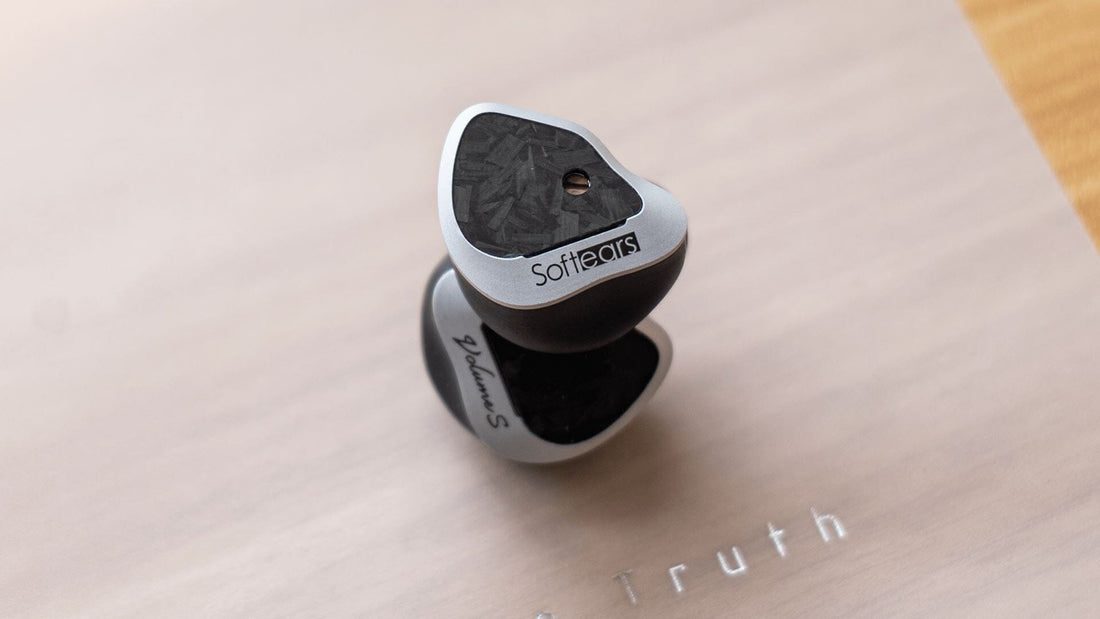
Before Softears’ new Volume S had arrived—two days before 2024 had ended—I’d felt it was a pretty disappointing year for IEMs.
Despite there being new evidence regarding how to achieve headphone-like neutrality in IEMs, most of the IEMs that came out in 2024 claiming to follow this guideline did so without considering how to best integrate this new knowledge.
While many sets like the Moondrop DUSK (with DSP), DUNU DaVinci or Kiwi Ears KE4 did end up having exceptionally natural midrange tunings, the midrange was the only area I felt they actually nailed; they weren’t actually “neutral” IEMs despite having neutral midranges. Instead, all of them would be better categorized as “V-shaped,” due to having a neutral midrange but—to my ear—too much bass and treble.
But as 2024 comes to a close and 2025 begins, I feel we’ve gotten the first IEM that indicates where IEMs will (hopefully) be going in the years to come, and one of the only IEMs I’ve ever encountered that I’d say earns the designation of “neutral” from top to bottom.
Enter the Softears Volume S, a $319 2 Dynamic Driver + 2 Balanced Armature IEM that skillfully balances bass, midrange, and treble, released just early enough to be crowned my favorite IEM of 2024. Let’s talk about why.
What we like
- Exceptionally balanced frequency response
- Proof positive that balanced tuning can also result in solid performance re: subjective qualities
- Cable is ergonomic and lightweight, comes with two layers of IEM protection
What we don’t like
- Midrange is okay for me but still isn’t perfect
- Shell is on the slightly large side, nozzle is a bit long
- Aesthetics seem a little confused to me
Build, Comfort, Design, and Accessories
Starting with the accessories, it’s mostly a modest package but with a few welcome surprises that help it land nicely compared to its competition. There are two sets of eartips in S/M/L sizes—Softears UC tips and a pair of generic black tips that also come with IEMs like the Moondrop Variations and Truthear Nova. The UC (Ultra Clear) tips might be better for those who find themselves getting less consistent seal, as the texture of those is very sticky which helps with maintaining seal integrity. I found both tips to be comfortable for me with only minor sonic differences between them.
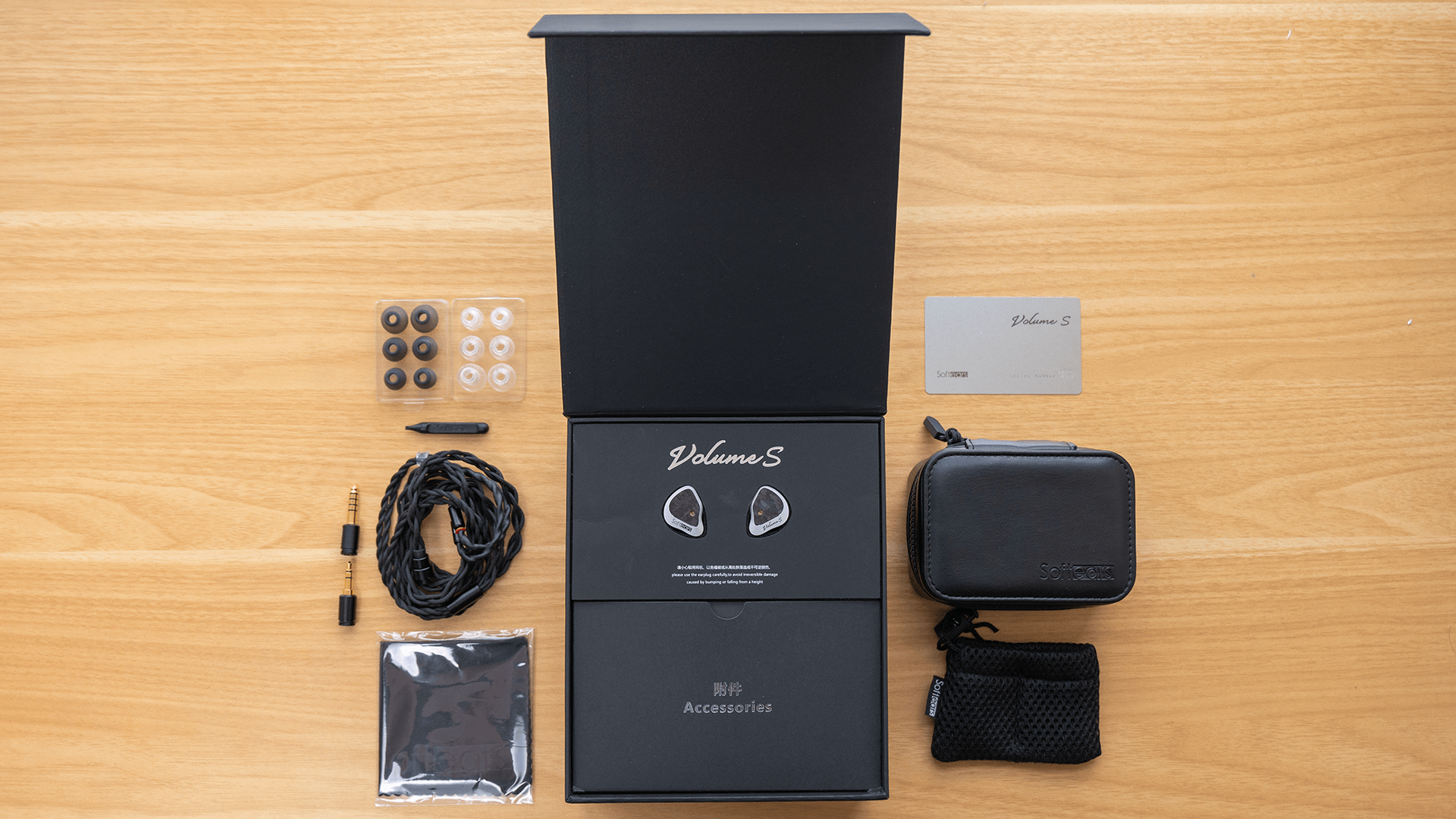
The first of the nice surprises is the included cable. It’s an extremely lightweight and pliable paracord sheathed 4-wire cable that terminates in a 3.5mm TRS connection with a swappable 4.4mm Pentaconn TRRRS termination. It’s incredibly comfortable to use and I don’t get any tangling or negotiability issues with regard to how it falls on my torso or at my desk.
I’m really not a fan of the rubberiness/tackiness of most other cables and the Volume S cable avoids that while being flexible, light, versatile, and a great color. However, one nitpick, the chin cinch doesn’t work all that well without giving extra attention to make sure it doesn’t awkwardly twist the earpiece-side connector cables.
But don’t get it twisted (ha): this is a great included cable, one of my favorites, and I have no desire to swap it with a different one.
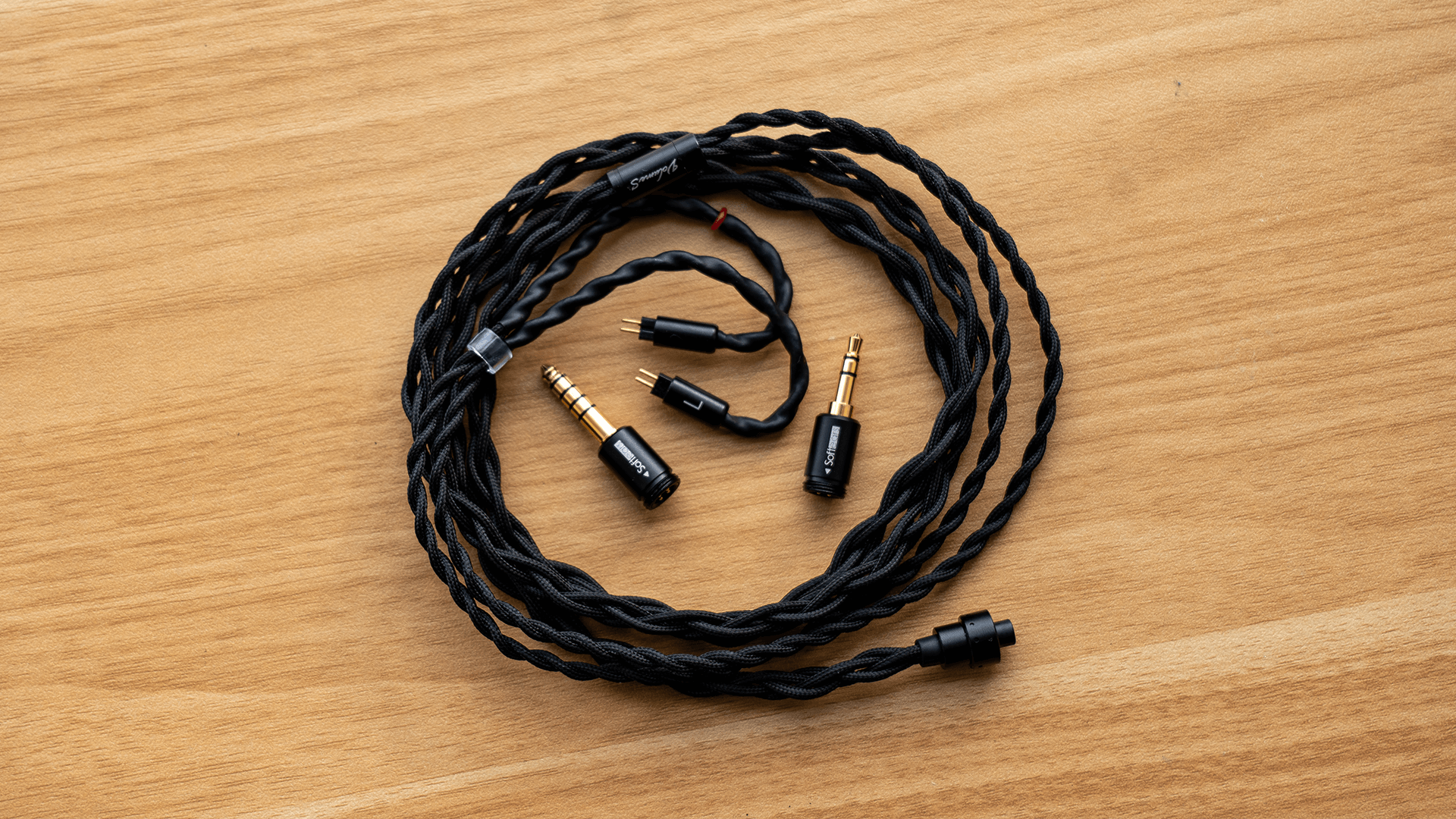
The next unexpected benefit is that it comes with an earpiece pouch for separating the IEM earpieces into their own padded sections for storage in whatever case you use. I love the inclusion of this, as I’m always a bit scared to let my IEMs knock against each other in whatever case I have them stored in, and I know many other enthusiasts use larger cases for holding multiple IEMs, so this would allow a bit more security in those kinds of storage scenarios.
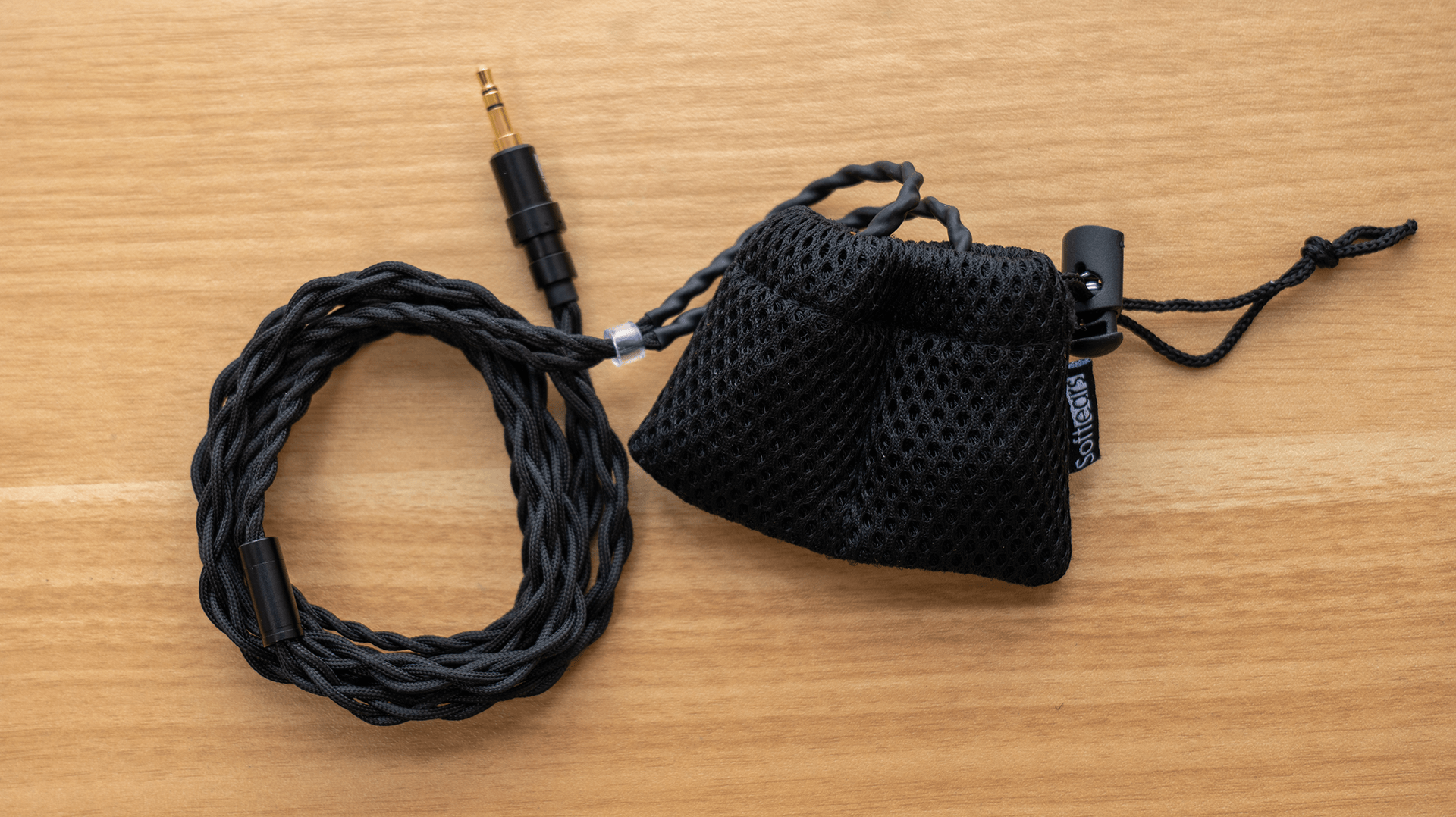
Speaking of which, the third nice surprise is that I actually quite like how the included rigid rectangular zipcase feels in the hand. It’s black and has a slightly plush leatherette exterior that looks quite classy. I’m actually likely to use this case for this IEM going forward just because I like how the plushness of the case feels on my fingers, but the inclusion of the earpiece pouch giving this IEM now two layers of protection—or protection regardless of what case is used—is, I think, an underrated offering that I wish more brands did in this price range.
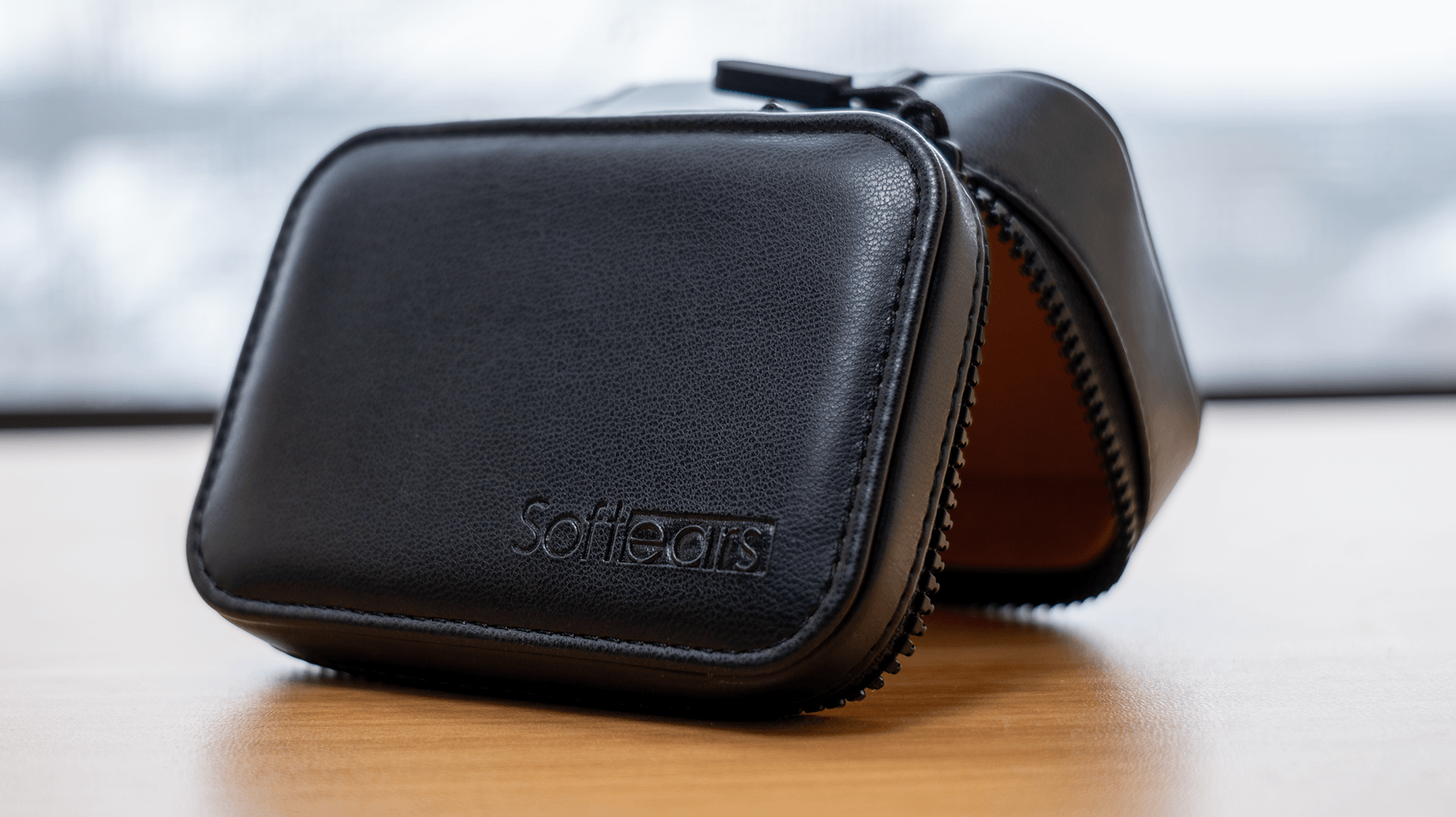 Moving onto comfort, the shell is on the large side with a fairly gentle molding to the part that nestles into the ear. The nozzle is fairly long at 8mm, but not especially wide at 5.4mm. It’s a ridgeless design, so it doesn’t have a lip at the end for retaining eartips. Some won’t like this, citing the possibility of eartips falling off and staying in your ear when you remove the IEM. Personally I’ve never had this issue provided the nozzle is long enough, and that seems to be the case here since this never happened to me with Volume S.
Moving onto comfort, the shell is on the large side with a fairly gentle molding to the part that nestles into the ear. The nozzle is fairly long at 8mm, but not especially wide at 5.4mm. It’s a ridgeless design, so it doesn’t have a lip at the end for retaining eartips. Some won’t like this, citing the possibility of eartips falling off and staying in your ear when you remove the IEM. Personally I’ve never had this issue provided the nozzle is long enough, and that seems to be the case here since this never happened to me with Volume S.
If I had to compare the comfort of this IEM to another, I’d compare it to the 64 Audio IEMs that come in the aluminum housing with the long/narrow ridgeless nozzle. I find those shells reasonably (though not exceptionally) comfortable, and I would say Volume S is similar if perhaps a tiny bit worse due to weight. That said, on the largeness of the shell alone I could see some people having more issues than I’m having with the comfort of Volume S, so be aware that this is a chunky boy.
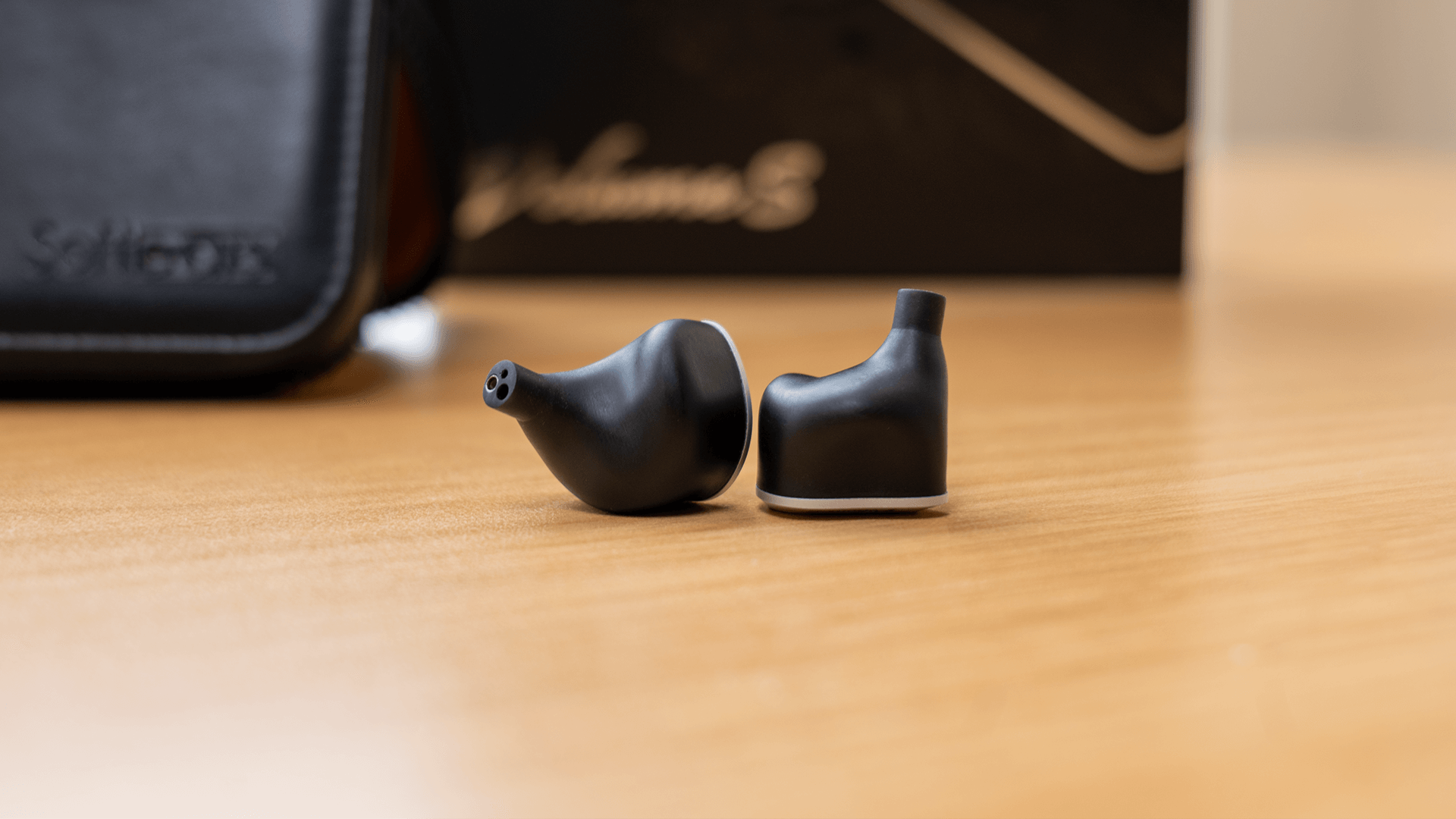
It seems the Volume S has a healthy amount of rear venting, though no front venting which is a bit of a shame. The former at least means I get a bit less of the occlusion effect—the feeling of uncomfortable low-frequency amplification that occurs whenever the eardrum’s air path is closed off—and less of a palpably “sealed” feel in my ear canal. Though to be clear, I could absolutely do with more venting here.
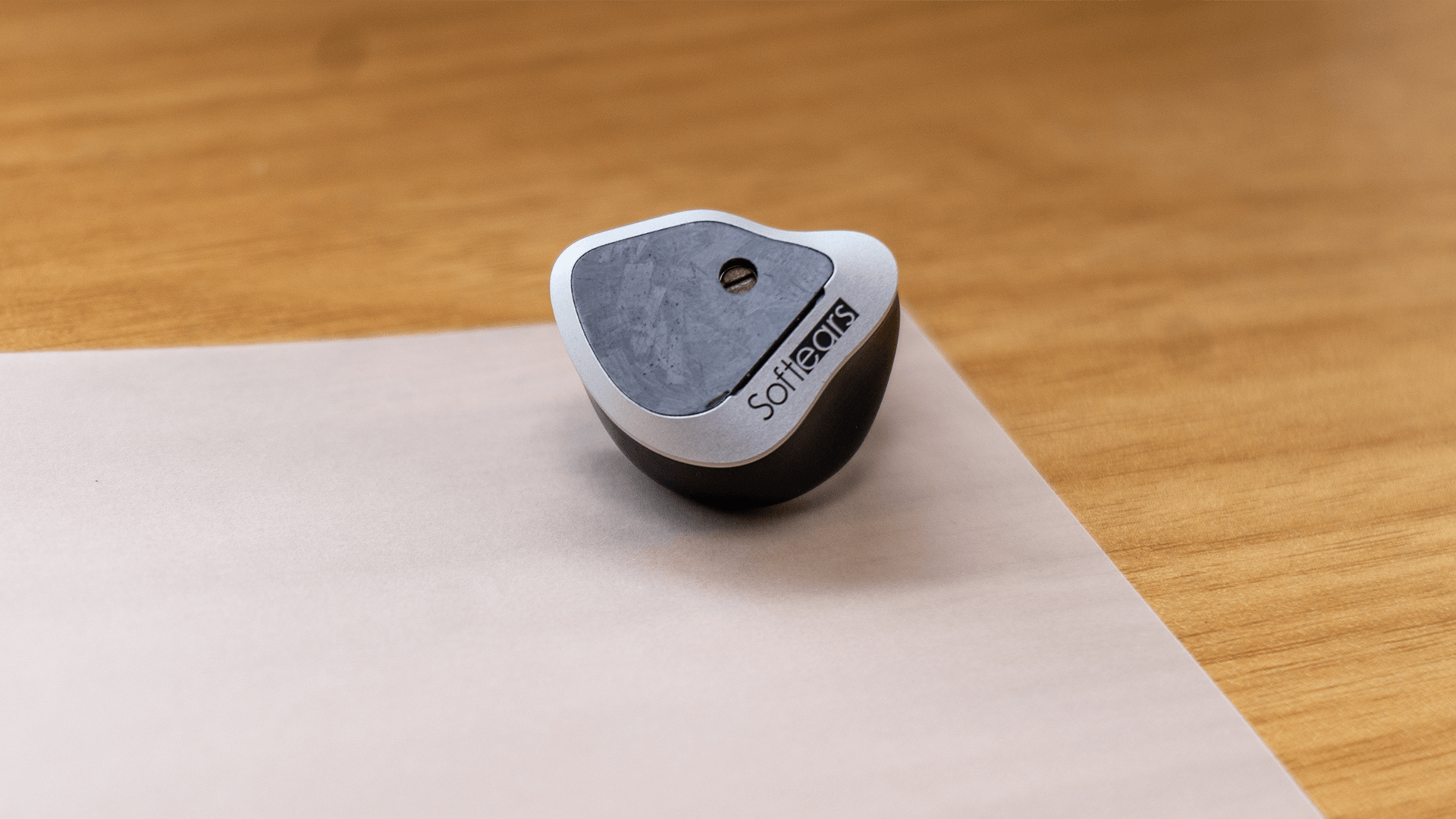
In terms of design, I’m not a huge fan of the aesthetic choices here, but I think my biggest issue was probably a compromise made on the part of the design team to hide a few features. The carbon fiber(?) faceplate insert is something that a few brands have done but I feel has yet to actually make an IEM look better than it would if it weren’t there. It’s seemingly there to help hide the slit-shaped vent that is directly underneath it, as well as make the Impedance switch (which we’ll get to) less visually jarring.
Overall in terms of “non-sound” factors, I think the Volume S has a pretty fantastic accessories package, comfort that works fine for me but might not for others, and a visual design that makes sense, but that I’m ultimately not a fan of. Definitely a good start, but let’s dive a little deeper.
Sound
Before we get into the sound portion, we need to discuss the Impedance switch that you’ll see on the faceplate of this IEM
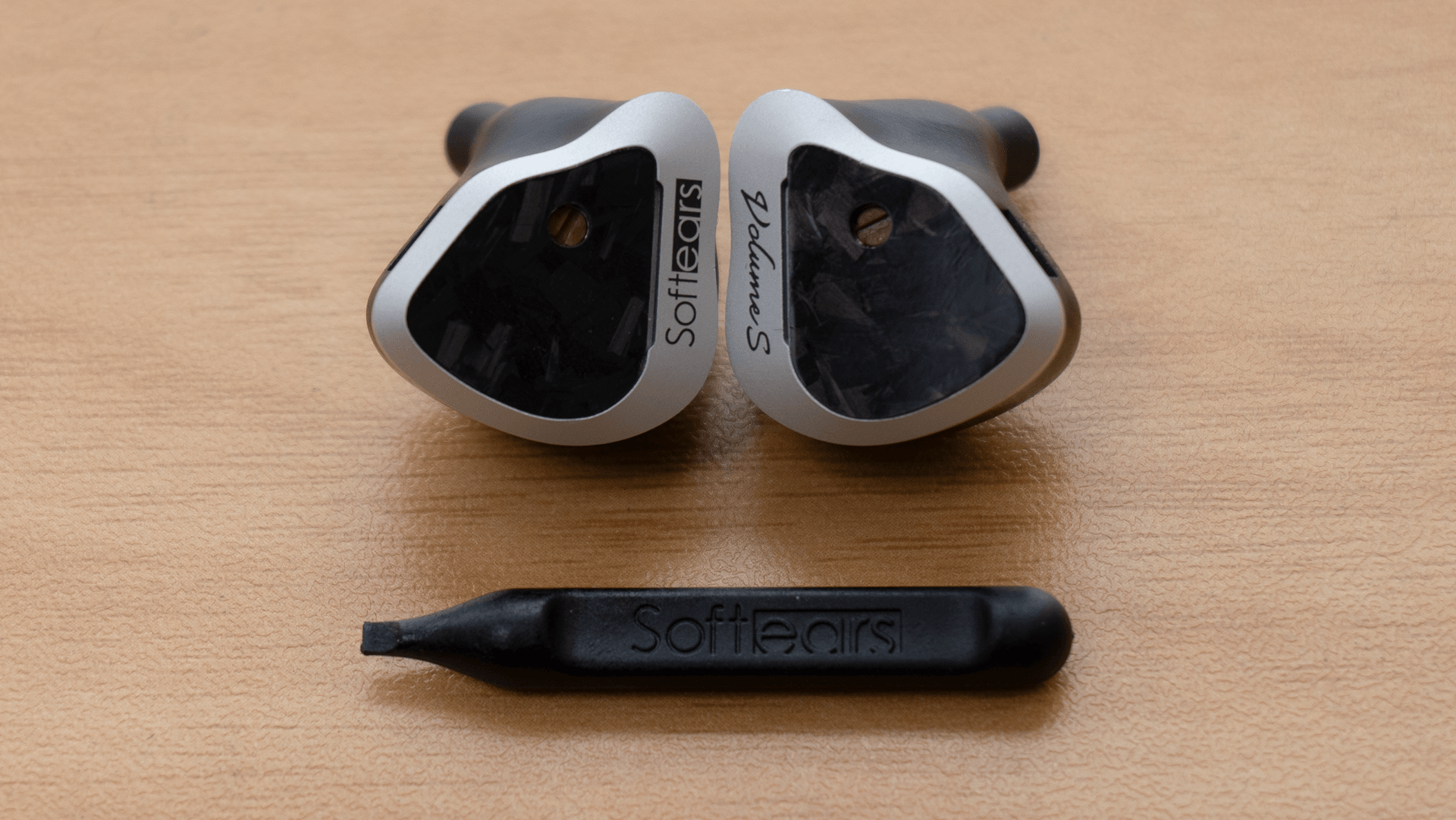
This rotary switch goes between two modes, both of which have different sensitivities and impedances, as well as different frequency responses. The specs, as well as the differences in tonality, are shown below:
Impedance:
Hi-Z: 31.2Ω @ 1kHz
Lo-Z 2: 9.8Ω @ 1kHz
Sensitivity:
Hi-Z: 114dB/Vrms @ 1kHz (95dB/mW)
Lo-Z: 124dB/Vrms @ 1kHz (103.9dB/mW)
The Hi-Z mode is considerably thinner & more upper-mid/treble focused, and honestly I’m not really sure why it was included to begin with. It sounds incredibly bright and wispy to me and I’d say it sounds less coherent and focused than even $20 sets tuned roughly to the Harman target like the Truthear GATe. For that reason, this review will solely focus on the Lo-Z tuning, shown with the two sets of included eartips below.
I opted to use the Black tips for most of this review as I found it made the treble just a bit rounder and more versatile for a variety of music, but I found both tips to sound pretty good with this IEM.
Starting from the bottom, the way this IEM presents bass might be a bit surprising to the enthusiasts who are used to getting “sub-bass focused” IEMs. Volume S is a little less focused on sub-bass, instead giving equal attention to sub and mid-bass, and a little extra love to upper-bass. The bass under 100 Hz being more reserved than usual results in the IEM having, to my ear, a less slow, less “fluffy” presentation than many of the sub-bass focused sets, while also being a bit more bloomy in the upper bass / lower midrange. However, the latter is something I personally don’t have a problem with due to the rest of the tuning, which we’ll get to in a second.
The upper-bass / lower-midrange bloom results in a subtly thickened presentation for male voices as well as snare drums, while not being overly bassy or stuffy on instruments like bass guitar or kick drum. This presentation is much more to my preference than the upper-bass / low-midrange recessed “contrasty” bass shelf we tend to get from many Harman-tuned or IEF 2020 tuned sets. But importantly, I also prefer it to the “warm mids and a ton of bass” tuning we’ve been getting from a lot of newer sets like the Kiwi Ears KE4 or DUNU DaVinci.
There’s less of an incoherent disconnect between bass and the midrange than the earlier types of tunings, but also less of a cloyingly thick, slow, and low-res feeling to the overall presentation than the more recent tunings.
The bass profile is the first spot where I think Volume S really makes itself distinct from its competition in a very good way. It’s got a great balance between note weight, size, and bloom, while not being a slouch in terms of quickness or impact either. I think the people who have found the current tuning trend to be making everything too damn sub-bassy or slow will really enjoy the subtlety of the sub-bass on Volume S. It’s there, but it’s not weighing everything else down.
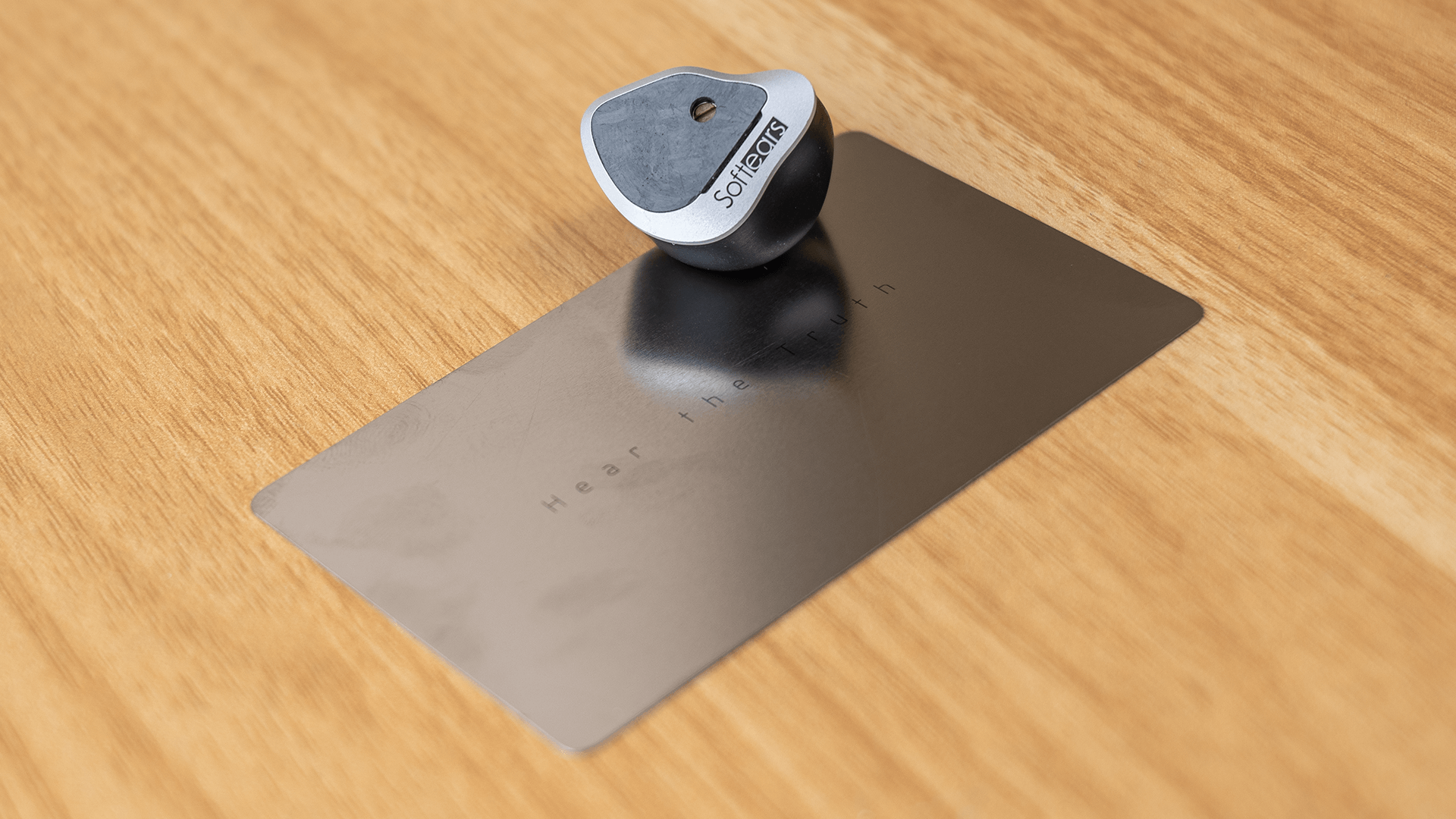
Possibly the biggest contributor to the bass sounding faster here is actually to do with the midrange, so let’s talk about that. While yes, this isn’t bang on “tilted Diffuse Field” adherent midrange, it’s well balanced enough that I’m not sure most will notice. While it might be a bit forward between 1-3 kHz with a small dip around 500 Hz, the slight upward tilt here plays very well against the bass profile such that I think the midrange presentation might also be a pleasant surprise for people.
With the Volume S, there’s a bit of bloom in the low-midrange to thicken vocals & snare drums, but it’s balanced by a bit of extra 1.5-3 kHz to make sure things aren’t too thick. This means things like guitars and pianos have enough attack and texture to sound timbrally and temporally correct, instead of muffled or lacking refinement. While this slight extra midrange forwardness was noticeable at times, it was exclusively on recordings where there was already quite a bit of aggression in this region from electric guitars or snare drums.
Additionally, this forwardness slightly limits my listening volume—if I push volume to where I'd like it, things can get a bit too harsh. That said, for the most part things sound like the fundamentals and harmonics are in a pretty respectable balance and I don’t get the excessively thin male vocals or strings of Harman-tuned sets or the honky & small sounding drums of IEF 2020 sets.
I’m pretty much the biggest stickler I know regarding this area of the midrange, but even I can’t help but admit that the balance here makes sense with the rest of the tuning of this IEM, even if it’s not perfect. If anything it evokes a slight bit of HD 600-esque intensity; the upper midrange would absolutely be too much if it wasn’t balanced by the slightly forward 200 Hz region, but thankfully the overtones are plenty balanced by the fundamentals such that the overall midrange here is what I’d call “good.”
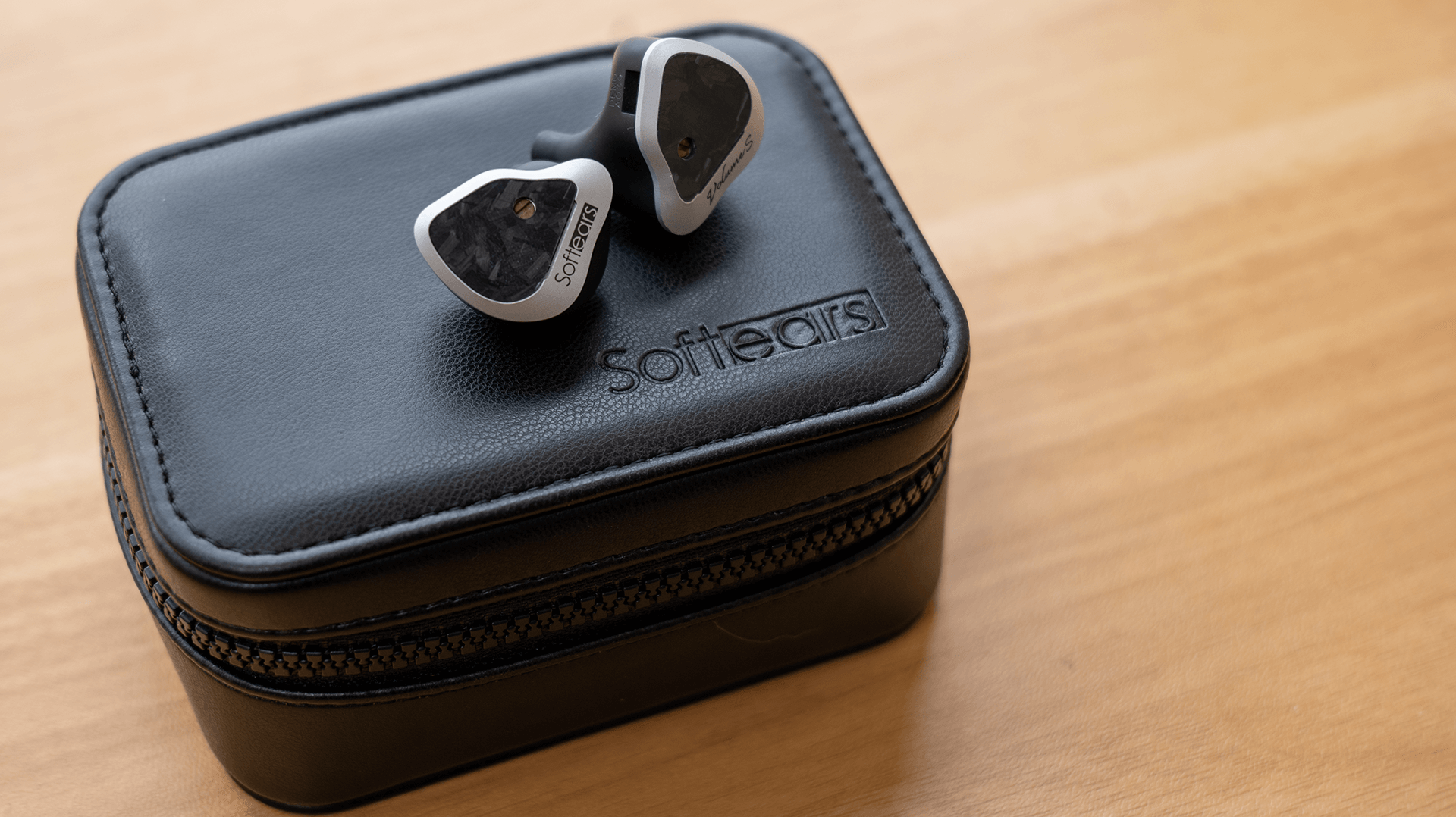
But that brings us to the final boss of the frequency response, and where my IEM reviews in particular tend to become a pretty dour affair: the treble.
If you’re familiar with almost any IEM review I’ve done, you’ll know that this is an area where I get bothered rather quickly compared to many other reviewers. I particularly have a sensitivity on IEMs and headphones around 10-12 kHz, and this is an area most IEMs tend to sound boosted even if the measurements & targets we use don’t show an obvious emphasis. Interestingly Volume S avoids overboosting this region, instead shifting most of its energy up towards 14 kHz where it’s less annoying to me.
There was a little extra heat on some vocalists around the 5 kHz area that highlighted a bit of crispiness and grain that seemed unnatural sometimes, but instances were few and almost entirely on records I know for a fact weren’t de-essed enough. Above 5 kHz though, hi-hats aren’t insanely sizzly and bereft of stick click, though they can have a little paperiness depending on the recording. Ride cymbals don’t have a ridiculous excess of ringiness or splash, acoustic guitars thankfully don’t sound overly wiry or chalky, and snare drums have enough emphasis on their chains to balance out the fundamental warmth and crack from the midrange while not being totally dominated by rattle or hash.
In most cases, the treble of IEMs serves as a masking influence that distracts me from naturally unpacking my music as I listen, making it very hard to accurately place elements in my headstage as well as accurately discern overtone presence in the midrange. This was much less of a problem with Volume S than with most IEMs I’ve reviewed, but it’s worth noting that even if this is one of the best treble presentations I’ve heard in an IEM, that’s likely because it fits rather well with my anatomy’s expectation of naturalness, and it may not fit as well with others’ depending on their anatomical expectations.
Overall though, Softears Volume S strikes me as one of the most coherent and well-integrated tunings around. Neither the bass nor the treble are overshadowing the midrange, and the midrange itself is a damn solid tune in isolation as well as deftly balanced with the bass and treble. There was basically nothing that sounded overtly, disastrously wrong with this IEM, and that alone makes it special in a market where I’ve essentially never come across anything well-rounded enough to say that about.
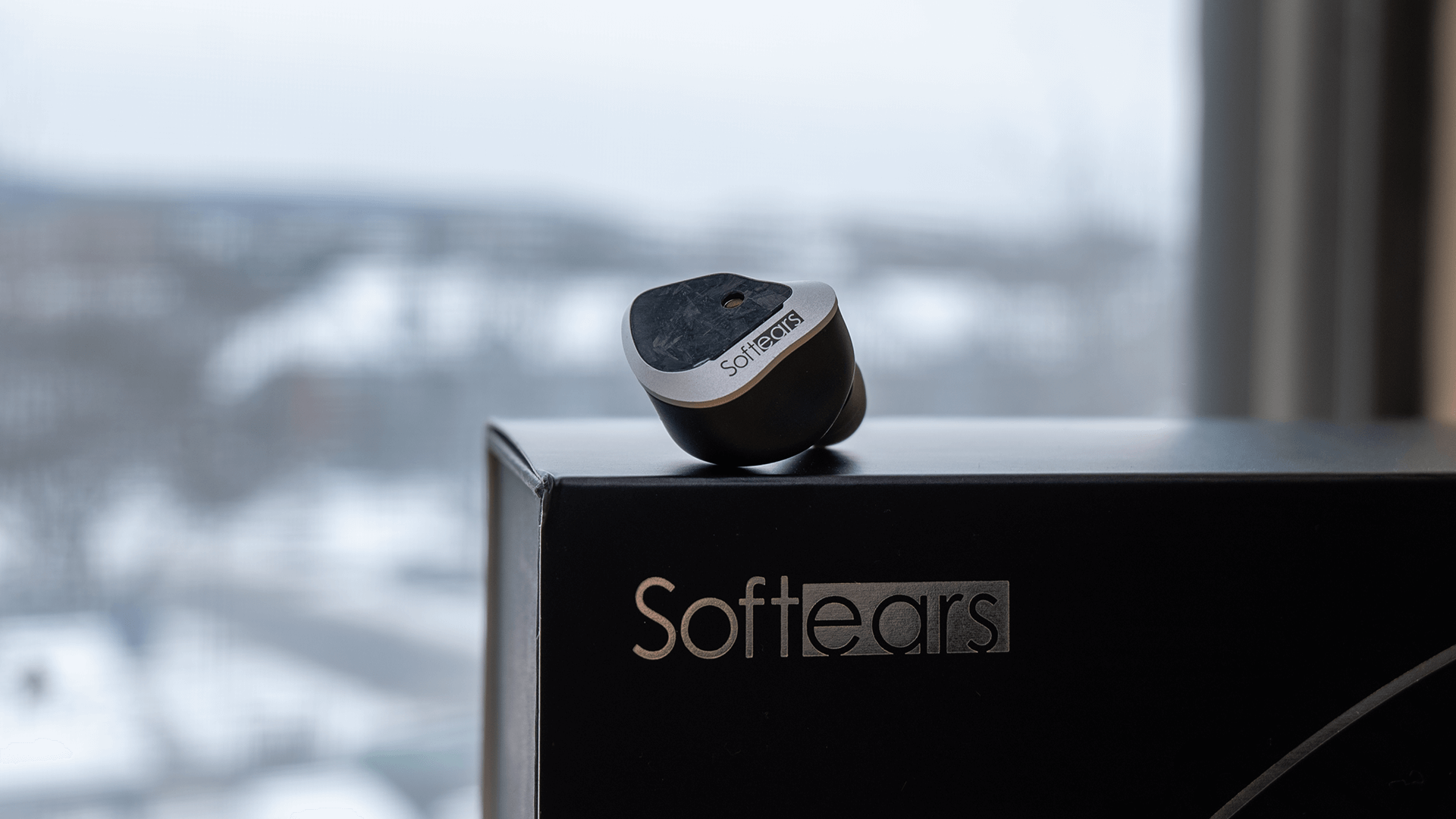
Subjective Presentation
To give a bit of context for those who might be confused about what I’m about to say about Volume S: Expensive IEMs are almost always the worst IEM experiences I have.
Most IEMs in higher price tiers sacrifice tonal balance in order to sound exciting, but it just never works out for me. What I tend to get from well-regarded sets like the Elysian Annihilator 2023 or Sony IER-Z1r isn’t “class-leading” sound quality, but instead overblown bass attempting in vain to be balanced by a boosted 1.5 kHz region & a ridiculous amount of treble that masks the midrange.
I say all of this because I think the Volume S is probably the most well-rounded IEM I’ve heard in terms of how it balances the aspects I care about (timbre, dynamics, image clarity) while not compromising tone or ruining the other aspects of presentation I care less about like the spaciousness or “detail”.
With Volume S I get a damn faithful representation of kick and snare transients both in terms of “punch and slam,” as well as how the physical size of these drums are represented relative to other instruments in the mix. This “size accuracy” is only true in a relative sense though, because while size contrast between sonic elements of mixes is great, things still sound small overall.
Importantly, the sense of dynamic impact doesn’t come at the expense of how well Volume S keeps up with changes of fast-paced music, which is an area I find Volume S to be much better than a lot of its competition. It’s a very agile set that, despite having a slight warmth to its presentation, has no trouble at all keeping up with fast paced DnB, rock, or metal tracks.
In terms of spaciousness, I find Volume S to be better than the average IEF or Harman tuned set but not quite as good as some of the sets with a more neutral midrange presentation like the DaVinci or KE4. Volume S does have a nice sense of reverb tail extraction that I could see others perceiving as extra spaciousness, but I do get a sense of images being a bit more close and “direct” than other IEMs i’ve heard in this price range.
Finally, in terms of detail I want to reiterate that Volume S is probably one of the least masking-prone treble responses I’ve heard in IEMs, and it also has a slightly forward upper midrange that nicely highlights overtones… thus the amount of image clarity and “detail” i’m getting across my music is much better on this set than frankly most if not all others I’ve heard.
There were a good few moments listening to this IEM where I felt meaningfully more keyed into a certain sonic element’s dynamic range, its placement in the stereo image, its degree of contrast from other sounds, and the totality of its texture than I have with any IEM in recent memory.
In other words, I think Volume S is a very detailed IEM, while not making you accept nearly the degree of tonal compromise other “very detailed IEMs” would ask you to accept. I fully expect some people to have issues with this section where I am effectively saying a $320 IEM is more detailed than any of the kilobuck IEMs I’ve heard, but that’s my truth and I’d be remiss to say anything else.
Now, that doesn’t mean you’ll get a similar presentation of these aspects, since I suspect much of this is down to treble—which is highly individual—but I do still need to say: Volume S should serve as a sign that detail is not just about boosting treble, but instead about offering a presentation that brings forward certain elements while not masking others or ruining the tone. Pairing that with the fact that Volume S is also a damn punchy IEM with solid textural nuance, speed, and layering, with its main compromise being the quality I care least about (spaciousness), I can’t help but feel like Volume S is an important step forward for a market of products that have perennially had trouble offering a balanced tonality and an engaging subjective presentation.
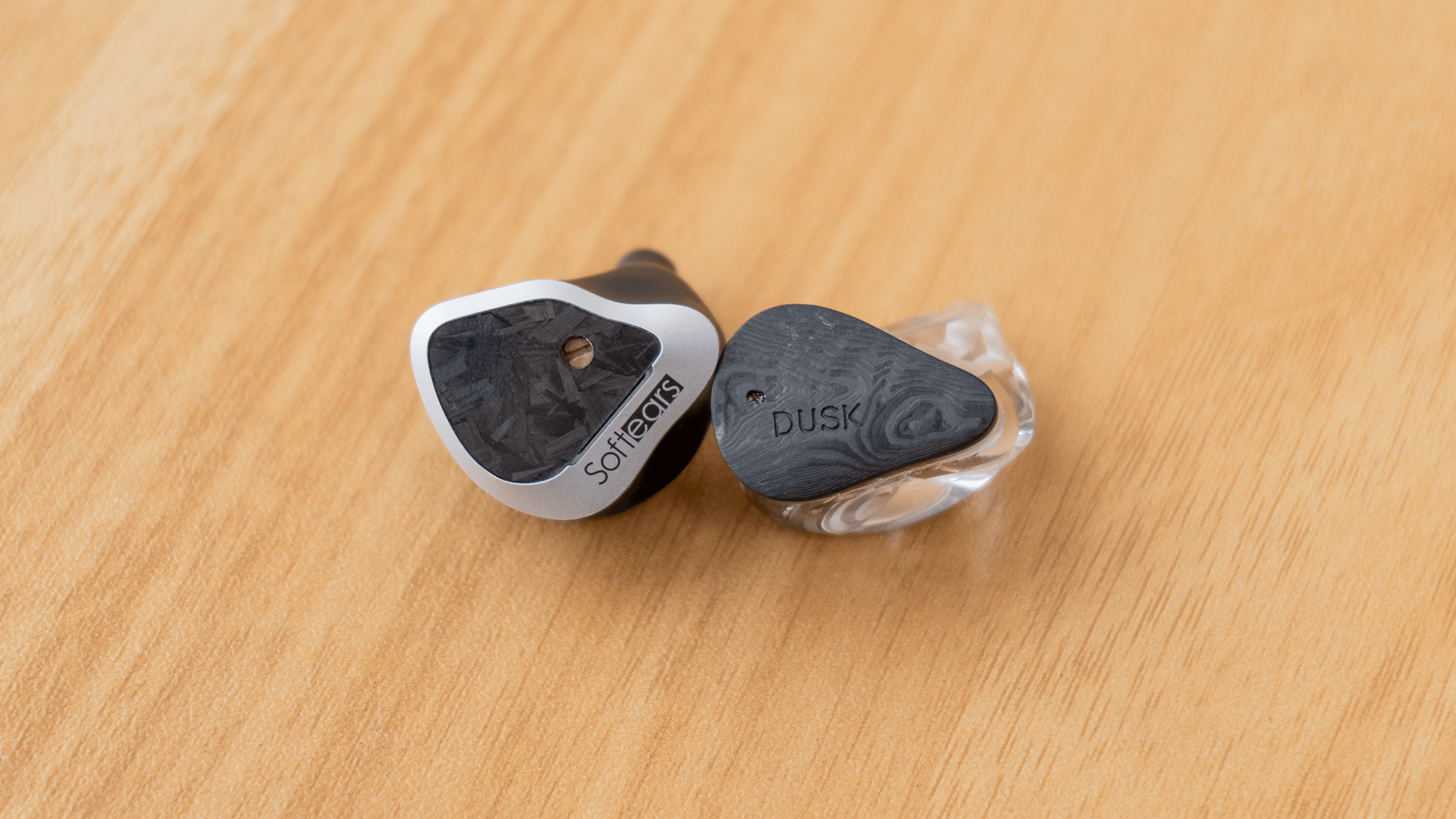
Comparisons
Vs. Moondrop DUSK
This comparison was made using the DSP Default preset for evaluating the DUSK.
I mentioned DUSK briefly in the intro, but I think it’s worth mentioning it again here because they’re so close in price and because I actually think they are different enough that people shopping in this price range need to be aware of how they differ.
In terms of non-sound factors, Volume S is an all-around better package for me. Comfort-wise, DUSK has a bit of a weird protrusion on the ear-facing side of the shell that never sat perfectly for me, and the shell is a bit too thick which causes the center of gravity to sit a bit too far outside my ear to be comfortable. Additionally, Volume S comes with much better accessories—the cable, case, tip selection are all just better for me overall. That said, I do prefer the look of the DUSK’s shell.
For me, DUSK wasn’t enjoyable without considerable extra EQ cuts (-6 or -7 dB) at 10 kHz and 14 kHz, Comparatively, this makes Volume S’s smoother upper treble response—and the ability to get this sound without having to use EQ software or hardware—an easy pick for me.
I also felt the DUSK was too sub-bassy for my preference, but I think I might actually be an outlier here; I think most other people found DUSK’s bass to be a highlight, so be aware: Volume S has less sub-bass and I prefer that, but you may not.
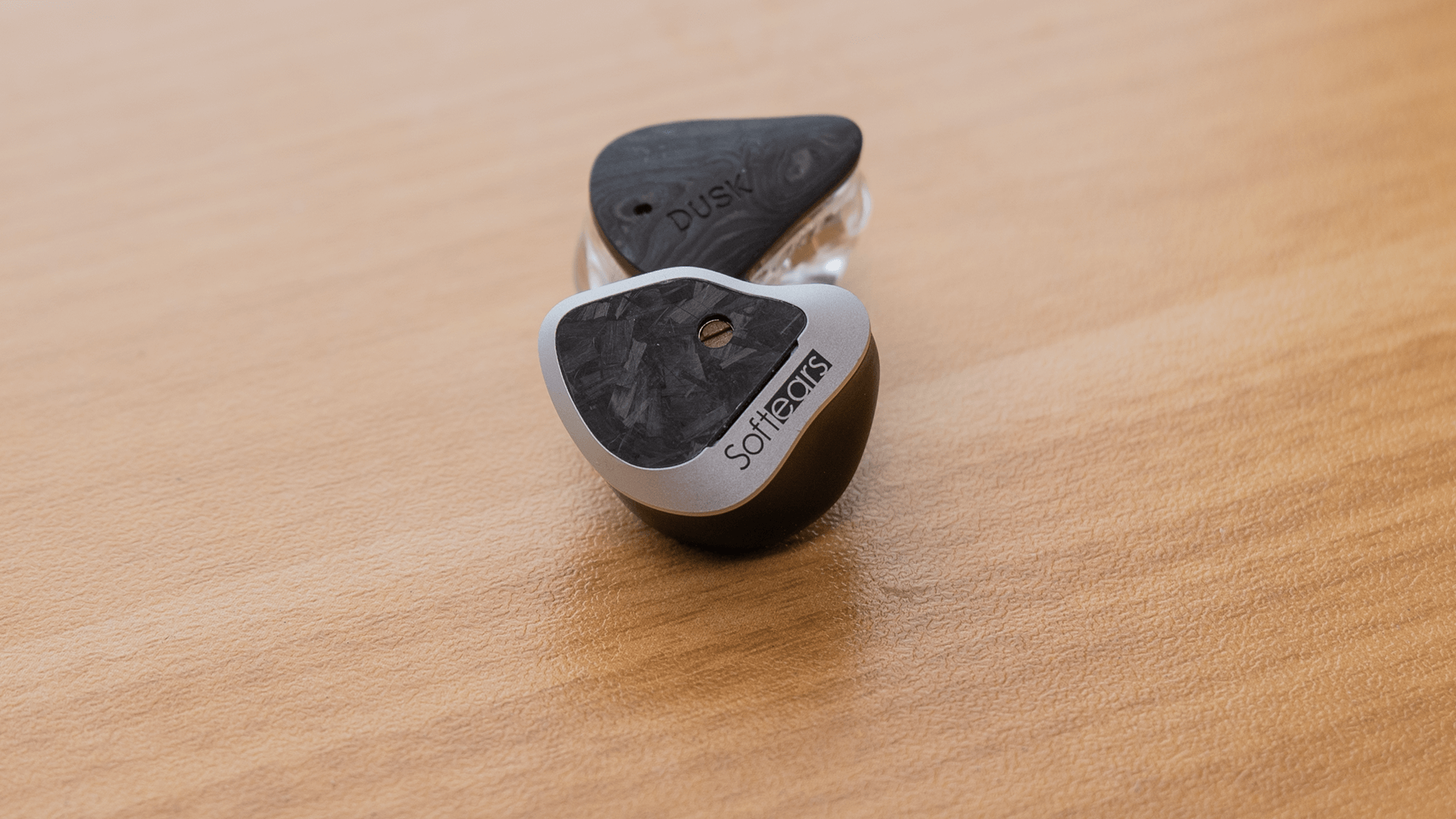
This did mean DUSK was a bit cloudy and slow for me at times, and I think that was both the sheer amount of sub-bass as well as how the excess bass paired with the relatively warmer midrange. Volume S’s bass-to-midrange integration is meaningfully better to my ear, because it has less sub-bass slowing things down, and its extra upper-bass emphasis is well-balanced by the upper-midrange forwardness. This means that, while Volume S has a little extra upper-bass warmth, it’s actually leaner and faster sounding than DUSK, while having a bit of extra texture in the overtones too.
In isolation, DUSK has a better midrange, but only in isolation. When you square a neutral midrange with a perceptually boosted bass and treble response, you get a V-shape, and I’m just not really a V-shape enjoyer. Even if the midrange is better on DUSK, it’s not as well-integrated with the rest of the response to sound overall more balanced. There were multiple times that I felt DUSK was too warm under 3 kHz and slow because of it, or too bright over 8 kHz and harsh because of it, but I never felt either of those with Volume S.
In terms of presentation, DUSK is a more spacious and relaxed sounding IEM for sure, and I think for people who need more upper treble for things to sound correct, DUSK might have overall better timbre too. But for me, Volume S is more dynamic thanks to having less sub-bass, more textured due to its slight upper-midrange emphasis, more detailed thanks to not having treble peaks causing a ton of masking.
Volume S, despite having a worse midrange tuning, overall sounds much more put together and neutral to me, simply because the midrange, while competent but not perfect, has a better balance with everything else around it than DUSK has.
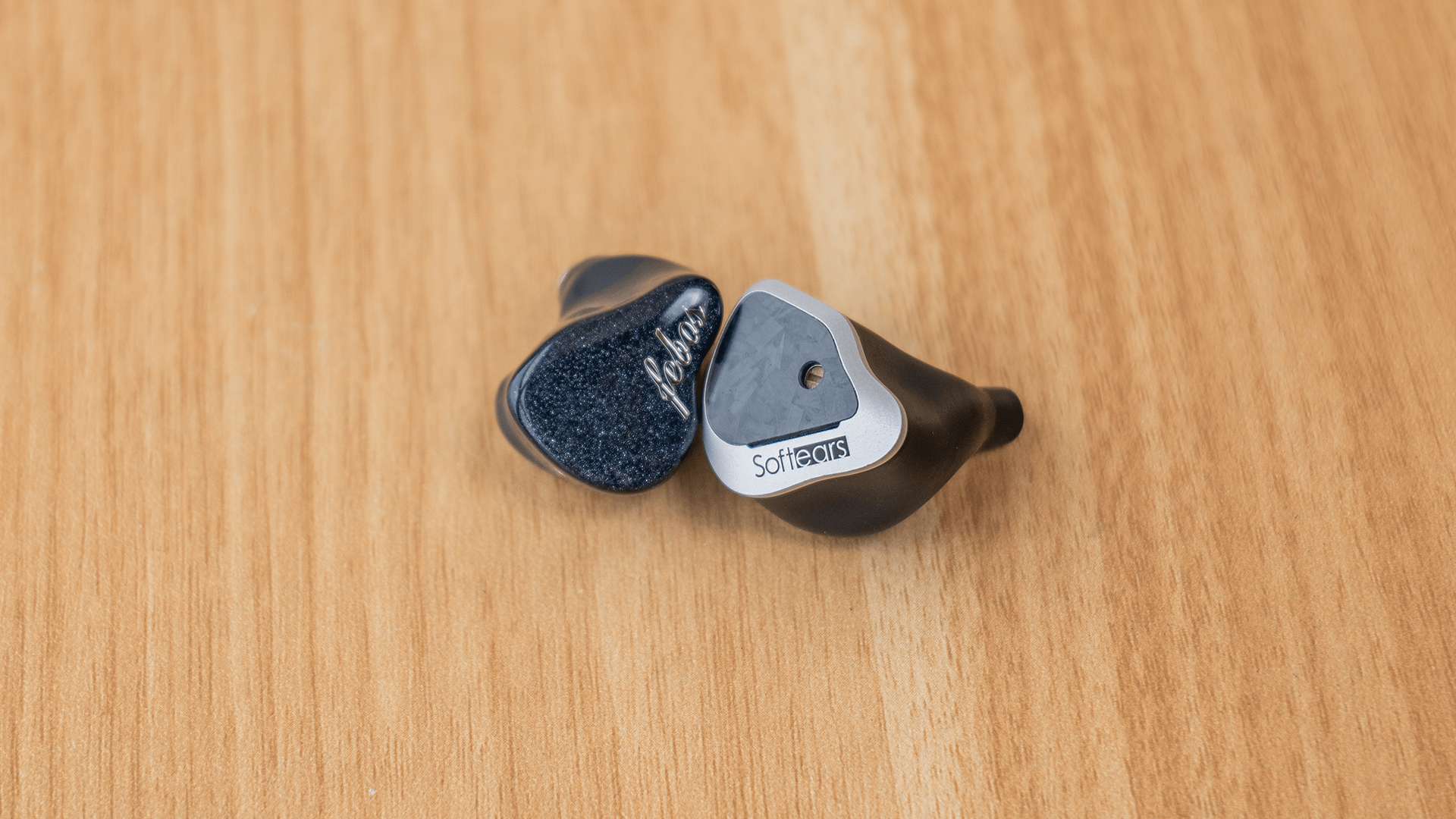
Vs. Hisenior Mega5EST
I’ll try to keep this short because the story is mostly the same for this as it is for the DUSK. While yes, I prefer the midrange of the Mega5EST in isolation, the Volume S overall sounds like a much more coherent and normal-sounding IEM because the Mega5EST has too much bass and treble for the style of midrange it has.
A common complaint about Mega5EST is that even though the tuning is “good,” it sounds boring, or that it sounds less technical than it should given the price. Personally, I think this stems from the tuning people insist is good actually having notable downsides.
The excess of bass paired with the warm midrange on the Mega5EST does make it a slower sounding IEM, and EQing it to have a bass profile more like the Volume S does help it become a lot more snappy and nimble feeling (as well as more textured and hard-hitting when it comes to bass instruments).
The same goes for the treble, where personalizing the Mega5EST for me entails making it a lot more like Volume S, and when I do this the imaging clears up considerably and I get a much better sense of separation and clarity of spatial cues.
While Mega5EST is an important IEM for our growing hobby, and still pretty damn hard to hate, I think it falls victim to the same issue the DUSK does: it’s V-shaped. If the magic is in the midrange—and make no mistake, it is—then even if we get the midrange right, a big part of competent tuning still has to include integrating the midrange with the areas surrounding it.
In my view, neither the Mega5EST nor the DUSK get this right, whereas the Volume S gets it more right overall, even if it's a bit less right in the midrange in particular.
Hisenior Audio Mega5-EST In-Ear Headphones
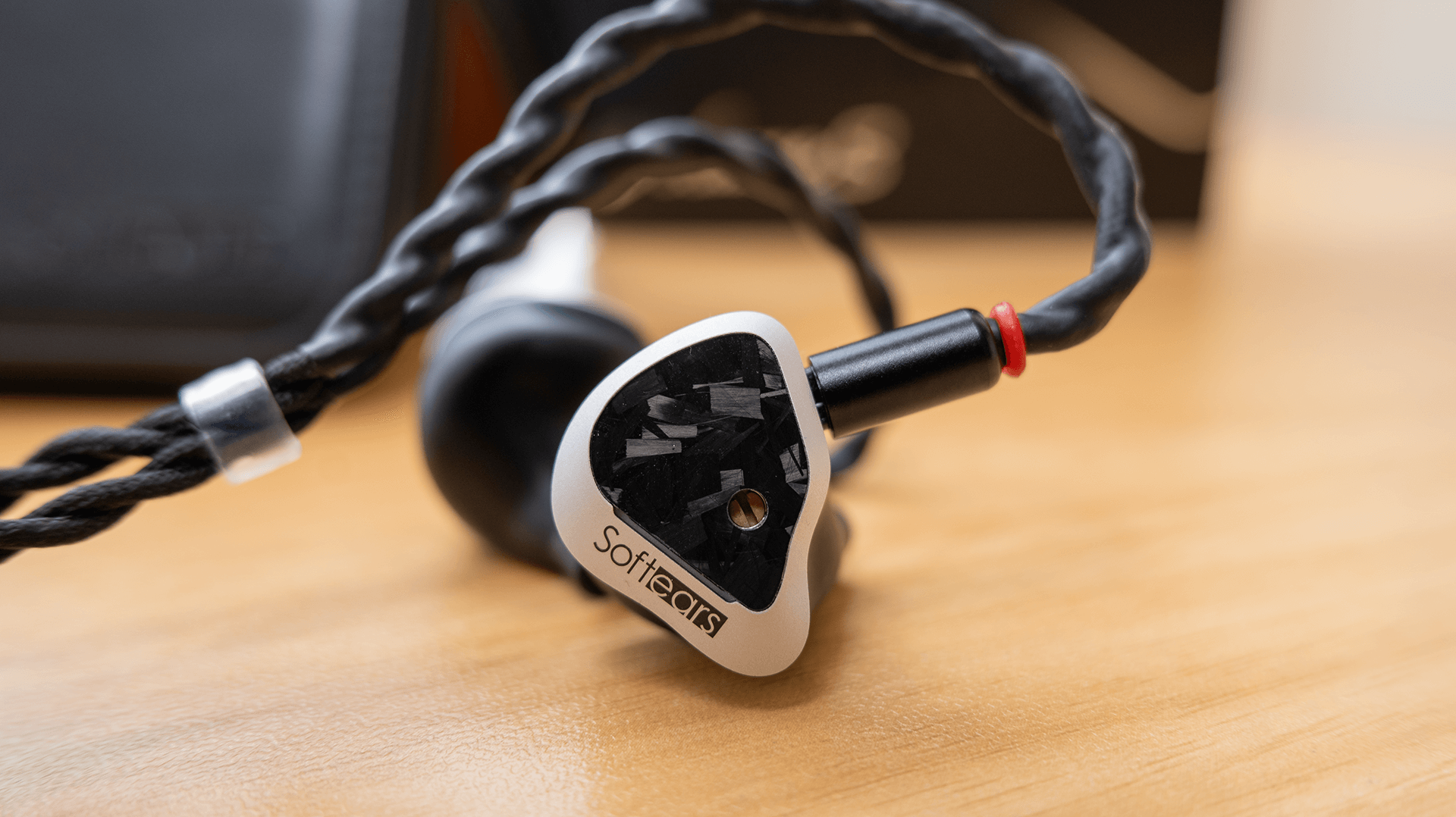
Conclusion
Like most IEMs, Volume S isn’t perfect, so it’s not like it’s going to be the best possible choice for everyone. Unlike most IEMs though, Volume S doesn't have glaring tonal flaws that would preclude me from recommending it to most people who’d want a balanced, all-rounder presentation.
Compared to Volume S, even IEMs I would consider safe recommendations—including but not limited to the Moondrop DUSK and Hisenior Mega5EST—are revealed to be meaningfully less versatile tonally while also less impressive subjectively.
So readers should be advised: Volume S is currently the IEM I’d be most comfortable recommending because of its exceptional bass-to-treble balance, solid subjective performance, and lovely accessories.
The downsides—midrange, ergonomics, and aesthetics—are either down to personal preference or minor enough that it’s still better than a lot of the other IEMs people (including myself) have recommended prior.
Bringing a little balance to the praise though, there’s still work to be done & IEMs are still improving… so I’m not sure how long a tenure I see in store for Volume S in our discourse.
Right now, it’s what I’d consider one of the best around—perhaps even the best—but it’s extremely likely something comes along with this sort of bass and treble but better midrange, better tuning overall, or similar sound with better ergonomics in the year to come. Because of this, in the coming year Volume S may eventually be less important or safe of a recommendation than I believe it currently is.
So while yes, I do recommend the Volume S—more emphatically than most IEMs I’ve recommended in the past—I’m still not sure I recommend it as much as I recommend waiting for better products to come to market. It is an important stepping stone, but I’m not quite convinced it’s the endgame a lot of us are still searching for.
If you have any questions or want to chat about this article, feel free to start a discussion below on our forum, or ping me in our Discord channel, both places where you can find me and a bunch of other headphone and IEM enthusiasts hanging out and talking about stuff like this. Thanks so much for reading. Until next time!

